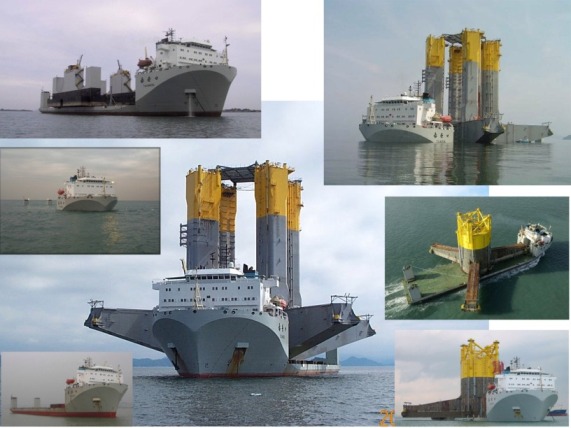Marine technology - application example
DasyLab can simultaneously visualize and archive 207 variables from the equipment of a semi-submersible
Heavy lift carrier in order to draw up a commissioning report. In Asia, I&S IP 9, the Marine Solutions subdivision
of Siemens AG, makes equipment for the electrical propulsion of semi-submersible heavy lift carriers.
Semi-submersible heavy lift carriers are floating platforms which can partly submerge themselves in the sea
so that their cargo deck is just a few meters below the waterline. Semi-submersible heavy lift carriers are used
for transporting floating vessels such as ships, submarines or parts of oil rigs. In order to place a load on the
semi-submersible heavy lift carrier, the load does not have to be lifted onto the cargo deck with a crane;
the semi-submersible heavy lift carrier partially submerges, the floating vessel positions itself over the submerged
cargo deck and then the semi-submersible heavy lift carrier rises again, lifting the vessel to be transported.

During loading or unloading, it is extremely important that the position of the cargo deck of the semi-submersible
heavy lift carrier is not changed. This is ensured by a DP system (Dynamic Positioning System). Two podded
drives (Siemens Schottel Propulsors - SSP), which are located at the stern and can be rotated through a full 360
degrees, position the semi-submersible carrier longitudinally and transversely while two bow-thrusters enable
transverse positioning.
These propellers and bow-thrusters are driven by electric motors, whose behavior is
controlled by SIMATIC S7 control units. Closed-loop control is provided by SIMADYN-D for the SSP propulsors
and by MASTERDRIVE for the bow-thrusters. The desired position is compared with the actual position, whereby
the latter is determined by a DGPS (Differential Global Positioning System). The result is passed on to the
SIMATIC-S7 control units, which then adjust the power output of the relevant electric motors.
The DP system can place the semi-submersible heavy lift carrier exactly in the desired position to an accuracy
of 1 meter. In order to ensure that the semi-submersible carrier retains its position even in choppy water and when
a strong wind is blowing, the electric motors must satisfy specific performance requirements.
This is checked by means of DasyLab.
Layouter creates clarity
Via an MPI/PROFIBUS cable, DasyLab reads 207 variables (power intake, temperature, speed, etc.) out
of the corresponding SIMATIC S7 control units simultaneously at a sampling rate of 2 seconds. It then visualizes
and archives these variables. With the Layouter function (available as an option) for DasyLab, the data are displayed
on the screen in a clear and easy-to-understand manner. It is, of course, impossible to display 207 variables at the
same time without causing confusion. The Layouter therefore makes it possible to switch back and forth between
different screen presentations (layouts), which can be printed and given to the customer as a commissioning report.
DasyLab - a convincing solution
DasyLab convinced Mr. Iden (Siemens AG) by its simple method of connection to a SIMATIC S7 and by its
straightforward and clear presentation of measured values using different screen presentations (layouts).




